
CULTURED MINDS
An Investigation of How Culture Affects Decision Making
STAGES / ART CONCEPT
(click to expand)

Original inspiration for my art installation came from a piece included in my GCSE art sketchbook: 'The Brain' made from a punctured balloon within a tangle of PVA-coated thread.

I have always been awed by beautiful forms in nature. This was a conker I kept for 3+ years to see what would happen when it dried: I was pleasantly surprised.

I found that adding blue clay to the folds of the conker made it look more brain-like. This image fit well with the topic of psychology which underpins my senior scholarship: Cultured Minds

I cut a hole to fit a USB stick into the conker-brain. This integrated the idea of technology/interconnectedness that I felt was another significant theme for my senior scholarship. Unfortunately (due to WIX terms and conditions) I was unable to load my website onto a USB stick. I decided to change idea as encouraged by my visit to the Saatchi gallery (next photo).

A trip to see Robert Wilson's installation (20:50) in the Saatchi gallery really impressed me. It inspired me to experiment with using liquid in my installation and convinced me that leaving the conker-brain + USB idea was the right decision.

After deciding that I wanted to incorporate water into my installation I decided to use a round glass bowl to represent a brain. Dropping ink into water (within the bowl) created a similar image of my 'The Brain' installation from GCSE (except in the medium of glass, water and ink rather than string, PVA and balloon).

I learnt how QR codes work and that a QR code could be used to link my website to my art installation - thus incorporating the aspect of 'technology/interconnectedness' that I had been searching for.

I laminated and submerged the QR code within the glass 'Brain'. I then used my phone to test if the QR code would work under water - it did.

To represent the cross-cultural aspect of my research and senior scholarship I envisioned that the glass 'Brain' be imprinted with the shape of different countries. The glass brain would thus serve as both a container of information (QR code) but also a display (world outline). I also like the way the circularity of the glass bowl mirrors that of a real globe.

I had 2 glass bowls. One on which I tested different techniques of gluing, adding water, and drawing etc. then the other final bowl where I applied all my finalised techniques.

I decided to use 2 magnets (one on the inside of the bowl, one on the outside of the bowl) to keep the QR code in place at the center of the bowl. This way the QR code could be manouvered into different places for maximum visibility and different visual effects.

I used a magnifying glass as the 'lid' of the brain/globe. This made the QR code easier to read and also made the installation seem more abstract (it is easier to associate the installation with a glass jar when it has the typical 'cork' lid). The magnifying effect also meant that from different vantage points around the brain/globe the QR code looks like it is different sizes. This raises the crucial point about differences in perception which is mentioned repeatedly throughout my report.

I found a thin wire stand (originally a cake-pan-holder) to display my installation. I chose this method because i found it the most visually appealing. Again, raising the globe/brain above the ground helped to make it seem more abstract and divorce it from the typical 'glass jar' image.

The final stage in my installation was to fill the globe/brain (with QR code submerged) with blue-tinted water. Unfortunately no photos of this final stage are available - I encourage the reader to look at the final piece in person.